Day 93-113: Desert wonderings
 December 27, 2016
December 27, 2016 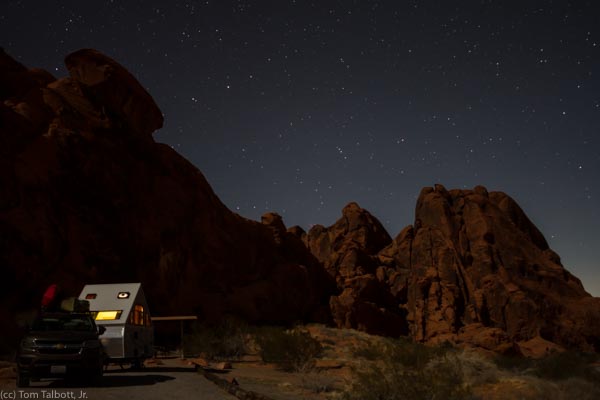
Under the stars at Valley of Fire
We left Zion on December 5, spent a day at St. George trying to fit in too many chores—laundry, groceries, and cleaning out the truck bed to discourage the rodent who had moved in while we were at Zion—then moved on to Valley of Fire, Nevada for two nights; then to Topock, Arizona for a week; then to Lake Havasu State Park in Lake Havasu City for six days; then farther south on Lake Havasu for Christmas. My thoughts this week are something like our travels: wandering and not staying in one place for very long. We have touched on so many new things and my mind is still trying to make sense of it all.
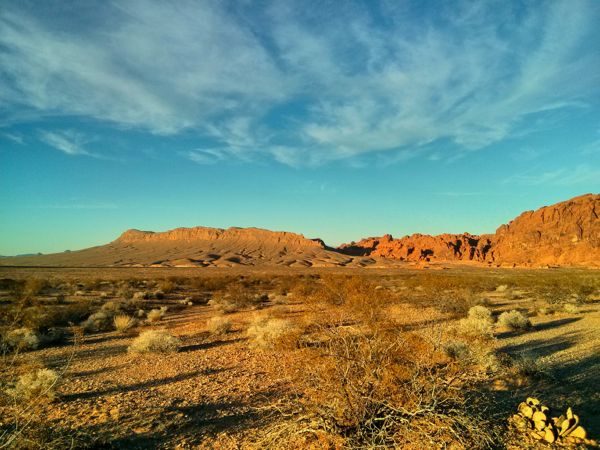
Valley of Fire in the Mohave Desert
Great Basin. Mojave Desert. Sonoran Desert. These names are beginning to mean something to me. After Zion, we left the Great Basin behind, with its high-elevation sagebrush and cold winters. From there we entered the warmer Mohave Desert, the driest of the US deserts, with its signature Joshua Trees. And now at Lake Havasu we are on the border of the Sonoran Desert, the warmest desert in the US, home of saguaros and mesquite trees. We are experiencing one of the characteristics of the Sonoran Desert this week, which is that in the winter, storms from the Pacific Ocean sometimes blow in bringing widespread rains. Though the hills around us are mostly piles of dry gravel dotted here and there with a few scraggly creosote bushes, the steady drizzle all night and the low clouds slung around the mountains this morning make it easy to pretend we are back home in Seattle.
This trip is helping me realize how profoundly we alter our environments. This is not news, and I don't know why this is more obvious to me out here than it was in Seattle. In a way, when you live in a big city for a long time it can come to seem like a kind of ecosystem of its own. The streets and buildings and people begin to organize into their own system and I sometimes forget that it is all constructed. But out here where so much is still raw land, the contrast is more obvious.
As an individual I feel pretty puny most of the time. We hike out into the Havasu Wilderness south of Topock, which has no developed roads or trails, and follow the burro paths out to the jagged barren mountains of broken rock and then down to the Colorado River in one of the few places where it still runs wild. It is a hot day, for winter, and it is clear that without planning and supplies we wouldn’t last long out here. The desert feels so much more powerful than us, something that could never be mastered or tamed.
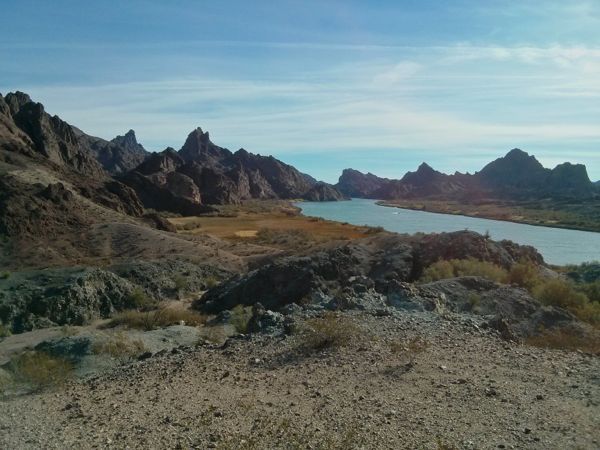
Colorado River in the Havasu Wilderness
However, when I see the miles and miles of solar grids being installed in the valley south of Boulder City, and the great towers of the power lines marching away from Hoover Dam, and the immense amount of water dammed in Lake Mead or Lake Havasu I wonder if even the desert will survive us: if we can appreciate its beauty, or recognize its inhabitants' lives as important, or really understand that we are embedded in a matrix of life on which we depend.
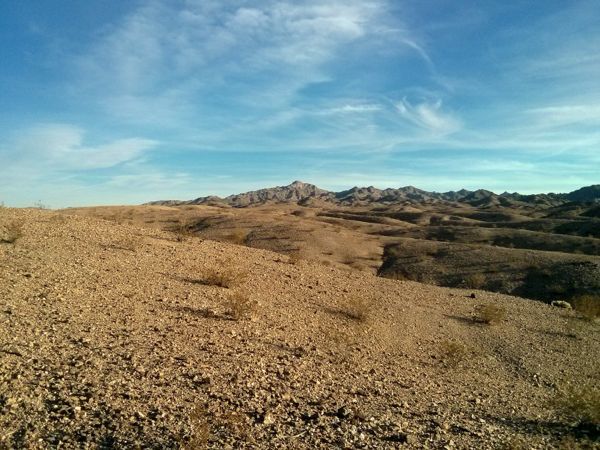
Havasu Wilderness
One of our neighbors at our campsite in Topock was trading stories with another man about favorite guns and talking about a cabin he owned and how great it was to sit inside the cabin and shoot coyotes. I got nine of ‘em last year, he exclaims with enthusiasm. Our RV Park is at the edge of a small square island of houses in the desert bordering the Havasu NWR, and every night we hear packs of coyotes yipping and yowling as they hunt the bare gravel hills around town and lope through our campground. Our first night there, something peed on the back window of our truck cab. I assume a coyote must have jumped up on the tonneau cover to investigate the tent we had stored there and decided to remind us whose home we were in.
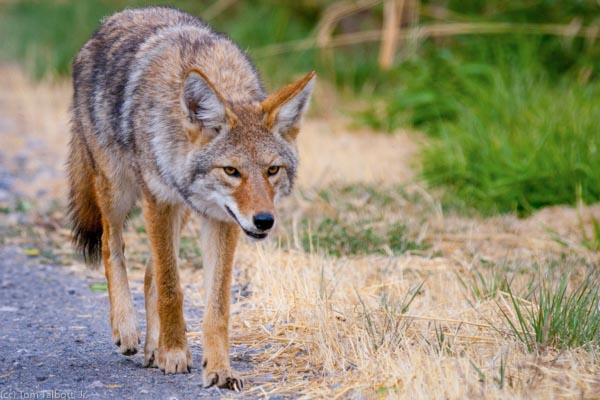
Then there was the day we drove from Valley of Fire to Topock, through some of the most spectacularly disastrous country I have ever seen. I do not understand the geology of this area yet, but clearly there has been some serious upheaval and the mountains are great rifts of rock, broken and tossed into near-vertical ridges and crazily-tilted crags in every color of brown, red, and black imaginable. Everything here is dry, dry, dry. Very little vegetation, and mile after mile of bare rock and brown washes and the smallest plants eking out whatever moisture they can from the coarse soil. In the distance, down the long, bare slopes, we get glimpses all afternoon of the great body of Lake Mead behind Hoover Dam, and see turnoffs advertising boat launches in a place where I would expect only the fossils of boats.
Then around a corner we come upon a vision so surprising I don’t even know at first what it is. Lake Las Vegas, like a little diorama of a city plunked without warning in the middle of the desert. Its brilliant blue water is surrounded by glass resorts and palatial Mediterranean villas in a tropical verdure of palms and grass and flowers. A mirage? A Hollywood set? A little research and I find that, no, it is “real” enough. A several-times-bankrupt business venture, the 320-acre “lake” and surrounding development was originally the brain child of actor J. Carlton Adair, though he was not able to see it through to construction. Other developers took it over and the lake was created by building an earthen dam on the Las Vegas Wash in 1988. The ambitious project has struggled though multiple bankruptcies, lawsuits, and economic downturns. But new investors are hopeful…
Now we are further south, camped on the shores of Lake Havasu, the lake created from the Colorado River by Parker Dam. It is beautiful, it provides water to many households and farms, and many people (including us) enjoy kayaking and fishing and boating here. However, it and the other lakes along the Colorado have drowned nearly all the cottonwood forests that used to line the whole lower Colorado. The Bill Williams NWR just south of us is one of the last stretches of original cottonwood habitat left, and it's nine-mile length is home to 11 species of butterfly that no longer live anywhere else.
Yesterday, I spot three huge rafts of Eared Grebes in the middle of the lake in front of our campsite. The lake is so big they are tiny specks even in my spotting scope, making them difficult to count, but I decide that a conservative estimate might be something like 5000 birds. I read in a book published in 1991 that Eared Grebes don't usually number over 2000 here in the winter, but then I find a December 10, 2011 report of over 5000 birds, and a December 7, 2014 report of over 30,000 birds (yes, that is the right number of zeros) on the lake, so perhaps my numbers are low. Would these grebes be here without the dam? I don't know. But I enjoy seeing them, and if I am very quiet I can just hear their whistling calls and the far rustle of their wings and feet as they move around on the water.
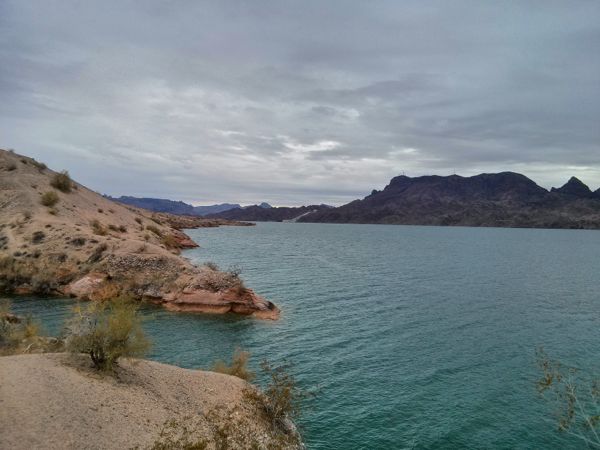
The Colorado River behind Parker Dam has become Lake Havasu. This is where I saw the Eared Grebes.
What we do is just as "natural" as these grebes. We are only doing what all animals do—living our lives, looking for food and water and shelter—only we have bigger tools and a greater reach. Many creatures alter their environments to suit them. The problem is just that we are very, very efficient at this. We can kill all the passenger pigeons. We can excavate an entire mountain for coal. And we can divert an entire river like the Colorado so it no longer reaches the ocean.
It is hard to realize as I sit on the shoreline here watching these lovely grebes and the other diving birds that feed here, that this lake is one of the reasons that water has not reached the Colorado River Delta in Mexico since 1998. (See link.) Same for the wonderful warm shower I can take for free in the campground, or the cool water in my pack, or the lettuce I bought at the store. Everything we do takes water, and unless we treat it like the precious resource it is, it can disappear.
Finding these things out first-hand hurts. I feel grief at all the things I didn't even know existed that are already gone. Cottonwoods, butterflies, pupfish, desert tortoises, whole ecosystems. And I also feel inspired by the resilience of what is here, and by the way life is continually adapting. The pain is worth it, because in return I have a larger, more inclusive view.
It is not about trying to make things stay the same. Change is happening all the time, with or without us. When you take the really long view, much of this area was underwater during the last ice age. Do I feel grief also for the lost Lake Bonneville? For the dinosaurs? And after all, we need power, we need water. I am very appreciative of both in my little home. But how much do we need and what do we use it for? How much is enough? Who decides? And who pays the price of those decisions? These are the agonizingly difficult questions that people have been worrying over for decades here, where water is scarce, and getting more precious all the time.
Perhaps not having a permanent home for now is helping me see how we are really always visitors in this world. How short our time is here; how limited our view; how much we do not know. I am inspired to respect this place I am visiting by becoming more aware of the water I use and try to make wise choices. And I am reminded of good traits for all visitors faced with the unknown: some humility, some patience, and a little stillness. I have been reading William Stafford—who is one of the best advocates I know for all three of these traits—and his words infuse the land around me.
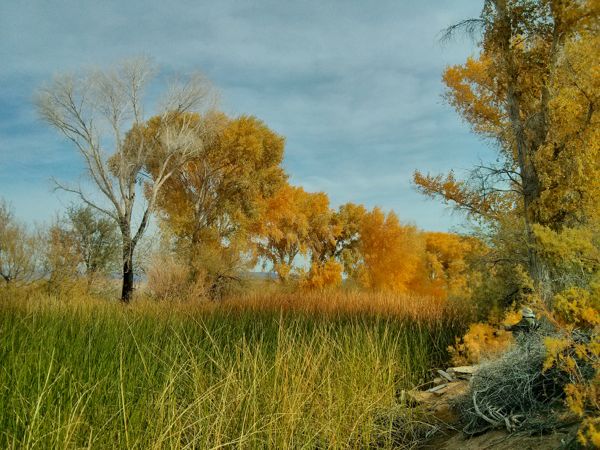
Pintail Slough in Lake Havasu NWR. A manmade marsh.